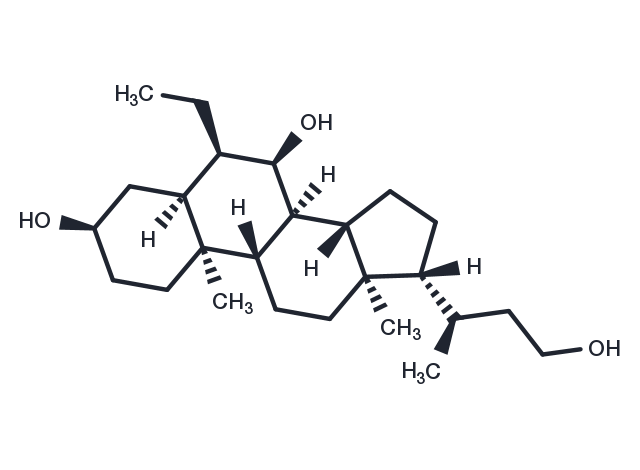Powder: -20°C for 3 years | In solvent: -80°C for 1 year
BAR502 is a dual GPBAR1 and FXR agonist (IC50s: 0.4 μM and 2 μM).

| パッケージサイズ | 在庫状況 | 単価(税別) | |||
|---|---|---|---|---|---|
| サンプルについてお問い合わせ | |||||
| 1 mg | 在庫あり | ¥ 24,500 | |||
| 5 mg | 在庫あり | ¥ 74,500 | |||
| 10 mg | 在庫あり | ¥ 112,500 | |||
| 25 mg | 在庫あり | ¥ 180,000 | |||
| 50 mg | 在庫あり | ¥ 250,500 | |||
| 100 mg | 在庫あり | ¥ 340,000 | |||
| 説明 | BAR502 is a dual GPBAR1 and FXR agonist (IC50s: 0.4 μM and 2 μM). |
| ターゲット&IC50 | FXR:2 μM, GPBAR1:0.4 μM |
| In vitro | At the concentration of 10 μM, BAR502 fails to transactivate GR, PPARγ, and LXR, respectively, but it transactivates the nuclear receptor PXR. BAR502 is able to induce the expression of proglucagon mRNA in GLUTAg cells, an intestinal endocrine cell line, as well as to increase cAMP concentrations in THP-1 cells. BAR502 induces the expression of OSTα, BSEP, and SHP in HepG2 cells. BAR502 shows very potent activity in the recruitment of SRC-1 coactivator and high affinity to FXR [1]. |
| In vivo | In non-obstructive cholestasis models, BAR502 mitigates liver damage without inducing itching. Concurrently, BAR502 enhances survival, lowers serum alkaline phosphatase levels, and significantly alters the liver's expression of key FXR target genes such as OSTα, BSEP, SHP, and MDR1, without causing pruritus. Furthermore, BAR502 treatment results in a 10% body weight reduction, heightened insulin sensitivity, increased HDL levels, and decreased liver steatosis, inflammation, fibrosis scores, and the expression of liver genes like SREPB1c, FAS, PPARγ, CD36, and CYP7A1 mRNA. It also elevates SHP and ABCG5 expression in the liver, alongside SHP, FGF15, and GLP1 in the intestine. Additionally, BAR502 fosters epWAT browning and curtails CCl4-induced liver fibrosis. |
| 動物実験 | C57BL6 mice 24 weeks old are fed a high-fat diet containing 60% kj fat and fructose in drinking water (42?g/L) or normal diet (6 mice) for 18 weeks. After 10 weeks of HFD, mice are randomized to receive HFD alone (9 mice) or HFD plus BAR502 (15?mg/kg/day) body weight by gavage (9 mice) for 8 weeks. Mice are housed under controlled temperatures (22?°C) and photoperiods (12:12-hour light/dark cycle), allowed unrestricted access to standard mouse chow and tap water and allowed to acclimate to these conditions for at least 5 days before inclusion in an experiment [3]. |
| 分子量 | 392.62 |
| 分子式 | C25H44O3 |
| CAS No. | 1612191-86-2 |
Powder: -20°C for 3 years | In solvent: -80°C for 1 year
DMF: 48 mg/mL (122.26 mM), Sonication is recommended.
You can also refer to dose conversion for different animals. 詳細
bottom
Please see Inhibitor Handling Instructions for more frequently ask questions. Topics include: how to prepare stock solutions, how to store products, and cautions on cell-based assays & animal experiments, etc.
BAR502 1612191-86-2 Autophagy GPCR/G Protein Metabolism FXR GPCR19 G protein-coupled Bile Acid Receptor 1 GPBAR1 BAR-502 NR1H4 Inhibitor G-protein coupled receptor 19 inhibit BAR 502 TGR5 inhibitor
